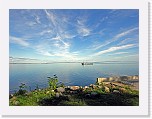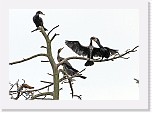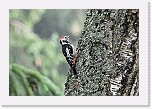<<- Main site
 2. - 4.7.2007
2. - 4.7.2007
LIETTUA: Neringa ja Kuurin kynnäs
Päätimme tutustua myös alueen turistinähtävyyteen Kuurin kynnäkseen. Se on satakunta kilometriä pitkä ja muutaman kilometrin levyinen hiekkasärkkä Klaipeda ja Kaliningradin välissä. Puolet kuuluu Liettualle ja on Unescon maailmanperintöluettelossa. Koko Liettuan puoleinen osa on Neringan kansallispuisto. Umpimähkäinen hotellivalinta Juodkranten kylässä osoittautui hyvin onnistuneeksi Kuršiu Kiemas. Sää oli vihdoinkin muuttunut hieman kesäisemmäksi.
Olimme kynnäksellä kaksi päivää. Tulopäivä oli kaunis, silloin pyöräilimme illalla. Toisena päivänä satoi, mutta seuraava oli taas aurinkoinen ja pääsimme pyöräillen tutustumaan ympäristöön. Kylä on mukavan oloinen ja muistuttaa jonkin verran 70-luvun Gotlantia. Tuntui ihmeelliseltä, että turistit olivat lähes pelkästään liettualaisia. Ulkomaalaisia autoja näkyi vähän.
Melkoinen "nähtävyys" on kylän eteläpuolella oleva merimetsojen ja harmaahaikaroiden kolonia. Opasteen perusteella rannalla oli muutama vuosi sitten laskettu 2400 merimetson pesää. Linnut pysyvät kuitenkin omalla alueellaan, eivätkä häiritse mitenkään turistien elämää. Pesimäpuut ovat luonnollisesti kuolleet mutta lähimetsä näyttää aivan normaalilta. Hurjan näköiseltä näytti, kun emo ruokki poikastaan. Se työnsi päänsä syvälle emon kurkkuun. Näytti ihan siltä, että poikanen etsi ruuan emon vatsan pohjalta.
Noitamäki kylän etelälaidalla on myös ehdoton nähtävyys. Siellä on vanhassa metsässä parin kilometrin "luontopolku", jossa vastaan tulee liettualaisia satuhahmoja puuveistosten muodossa. Sateisessa säässä oli ikimetsässä mukava kulkea.
Kalastajat oli täällä aikoinaan velvoitettu käyttämään erikoisia tuuliviirejä veneissään. Oleellista niissä on kalastajalle sallittua aluetta osoittava lippumerkki. Toisen alueelle ei ollut menemistä. Kaikki muu rekvisiitta viirissä on pelkkää mielikuvitusta.
 Valokuvia
Valokuvia




 2nd - 4th July, 2007
2nd - 4th July, 2007
LITHUANIA: Neringa, the Curonian Spit
We decided to get acquainted with the local tourist attraction, the Curonian Spit . It is about a hundred kilometers long and a few kilometers wide sandbank between Klaip?da and Kaliningrad. Half of that includes to Lithuania and is in Unesco´s World heritance catalogue. The Lithuanian part of that is National Park of Neringa. Our arbitrary hotel selection in village of Juodkrante proved very successful Kuršiu Kiemas. The weather was finally changed a little bit to summer.
We were on Spit two days. Date of arrival was beautiful and we cycled around in the evening. On the following day it rained but next was again sunny and we decided to cycle to get acquainted with the environment. Juodkrante village proofed to be on nice place and reminded a little bit Gotland of the 70´s. We found it bit strange that most tourists were merely Lithuanian. A foreign car was sawn only few.
Considerable "sight "here was a colonna of the great cormorants and grey herons on the south side of village. It was a few years ago calculated here 2400 nests of great cormorants. However they stayed by their own area and didn't any way disturbed tourists. Nesting trees have naturally died but nearest forest shows to be in quite normal condition. It looked reckless, when mothers feeded their babies. It pushed its head deeply to the throat of the mother. It showed quite that kid searches food from the end of the mother stomach.
Devils Hill on south fringe of the village is also absolute attraction. There is in old forest nature path of the couple kilometers in which you can meet Lithuanian fairy tale creatures in the form of the wooden sculptures.
The fishermen were here in old days obligated to use special weathervanes in their boats. Essential in those is the flag mark indicating for the each fisherman permitted special area. To another's area had not been going. All other properties in flag are mere imagination.
 Pictures
Pictures
 2. - 4.7.2007
2. - 4.7.2007
 Valokuvia
Valokuvia



 2nd - 4th July, 2007
2nd - 4th July, 2007